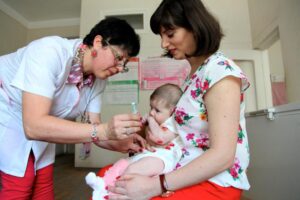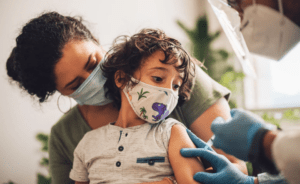Estimated reading time: 6 minutes
 The Linked Immunisation Action Network (Linked) hosted a learning exchange with middle-income countries from the European Region to discuss the use of financial and non-financial incentives to increase immunisation coverage. This webinar was a follow-on to a Linked workshop in July 2022 on the integration of immunisation and primary health care (PHC). The workshop covered three key topics, including coordination with other PHC services, health worker capacity and motivation, and monitoring and measuring performance. The workshop also briefly touched on the use of incentives to strengthen health worker performance to increase immunisation coverage, and participants were interested to dive deeper and requested an additional collaborative learning session on this topic. During the learning exchange, a presentation on the most recent global evidence on incentives was followed by a presentation on Armenia’s experience introducing a pay-for-performance mechanism and then a presentation on the design of Georgia’s PHC payment reforms which will be introduced in 2023 and includes both financial and non-financial incentives.
The Linked Immunisation Action Network (Linked) hosted a learning exchange with middle-income countries from the European Region to discuss the use of financial and non-financial incentives to increase immunisation coverage. This webinar was a follow-on to a Linked workshop in July 2022 on the integration of immunisation and primary health care (PHC). The workshop covered three key topics, including coordination with other PHC services, health worker capacity and motivation, and monitoring and measuring performance. The workshop also briefly touched on the use of incentives to strengthen health worker performance to increase immunisation coverage, and participants were interested to dive deeper and requested an additional collaborative learning session on this topic. During the learning exchange, a presentation on the most recent global evidence on incentives was followed by a presentation on Armenia’s experience introducing a pay-for-performance mechanism and then a presentation on the design of Georgia’s PHC payment reforms which will be introduced in 2023 and includes both financial and non-financial incentives.
What we learn from the global evidence on incentives. Dr. Akaki Zoidze, a senior expert in health policy, health systems, and health financing with the Curatio International Foundation, presented an overview of the evidence on financial and non-financial incentives to improve immunisation coverage with the following key findings:
- When considering the linkage between incentives and health worker motivation, income and the perception of a fair distribution of incentives were positively associated with higher job motivation.[1]
- Pay-for-performance (P4P) had no significant impact on neonatal mortality, but there is some indication that it may lead to a higher rate of full vaccination and immunisation coverage, with one study showing an almost 40% increase in the likelihood of children being fully vaccinated.[2]
- P4P, along with other critical features, including transparency and accountability reforms, resulted in increases in the coverage of health services but rarely resulted in improvement in the quality of services delivered. P4P offers similar gains as direct facility financing approaches, which transfer funds and have transparency and accountability reforms but do not have specific incentives for health workers and the associated monitoring.[3]
- When the contextual factors associated with the effectiveness of P4P schemes were considered, the following common pathways led to improved outcomes: community outreach, adherence to clinical guidelines, patient-provider interactions, patient trust, facility improvements, access to drugs and equipment, facility autonomy, and lower user fees. [4]
- Contextual factors shaping the system response to P4P include the degree of facility autonomy, efficiency of banking, role of user changes in financing public services, staffing levels, staff training and motivation, quality of facility infrastructure, and social norms within the community.[5]
- Program design features supporting or impeding the health system effects of P4P included the scope of incentivized indicators, fairness and reach of incentives, timely payments, a supportive and robust verification system that does not overburden staff, provider autonomy.[6]
- If health system inputs are vastly underperforming pre-P4P, they are unlikely to improve only due to the introduction of P4P.
- Providing opportunities for further development of a health worker’s career is a critical, non-financial incentive to motivate health workers and retain ambitious staff.[7]
- A mix of well-designed financial and non-financial incentives are likely to be most effective in motivating health workers.[8]

Armenia’s experience. Dr. Varduhi Petrosyan, a professor at the American University of Armenia, presented on Armenia’s experience implementing a P4P scheme since 2009. The initial pilot began with a small number of indicators. Incentive payments were the equivalent of 10% of provider income and were distributed on a monthly or quarterly basis. When it was scaled up nationwide, incentive payments were only equal to 3% of provider salary and were distributed annually. With support from the World Bank, incentives were increased to 6% of provider income and distributed twice per year. There are ongoing discussions with the Armenia government to increase payments to 30% of provider payment and to further increase the frequency of payment distribution. Incentive payments are paid to the facilities which are obligated to spend at least 80% on provider bonuses with the remainder available for direct administrative expenses at the facility. Initially, there was 1 immunisation indicator, but by 2019, there were 32 indicators included within the P4P scheme, with 6 related to immunisation. Ongoing discussions to further reform the P4P scheme include the introduction of 5-6 new immunisation indicators focused on adolescents. To increase transparency and accountability, the World Bank introduced a website for providers to view their performance and payment amounts.
Armenia’s P4P scheme is generally considered a success with utilization of PHC services initially doubling, but the utilization of services has remained stable since 2013. A 2016 assessment by the World Bank found that the scheme was progressing well and meeting annual targets to improve maternal and child health services in PHC facilities. The assessment identified the following enabling factors: P4P resonated with national policy makers who wanted to strengthen PHC; close collaboration between global technical experts and national actors who took ownership of the scheme and allocated financial resources for implementation; coordination between the various departments within the MOH and the MOH and the Ministry of Finance, Ministry of Territorial Administration, and the Provincial Governor’s offices; and inclusion as but one component of a multi-dimensional health reform package. The assessment also identified the following barriers: the 2008 global economic crisis which caused a reduction in the amount of the incentive payments (the reduction from 10% to 3%); the lack of provider participation in the decision-making; the smaller incentive payment amount (3%) and infrequent payments (annually); and finally, burdensome paperwork (both hard-copy and digital record entry). The assessment recommended an increase in the incentive payment, a transition to fully digital monitoring, the introduction of new quality indicators, and increasing the community’s trust and respect of PHC providers.[9]

Georgia’s experience. Dr. Akaki Zoidze then presented on Georgia’s planned health system payment reform scheme, scheduled for implementation in 2023. It will include incentives to provide essential services, such as immunisation, in combination with other enablers to ensure improved outcomes, such as a monitoring and accountability framework and supportive supervision. In urban areas, PHC is delivered through private facilities. Incentive payments will be distributed to the facility, and they have complete autonomy to decide how payments are used. In rural areas, PHC is largely delivered through public facilities. For these facilities, professional medical associations will conduct supportive supervision visits which are a key element to ensure not only improvements in utilization but also the delivery of quality health services. While outcome indicators are not part of the P4P scheme, they are included within the accountability framework.
Many countries attending this exchange developed action plans during the workshop that included the introduction of both financial and non-financial incentives to improve immunisation programme performance, and the Linked Immunisation Action Network will continue to facilitate collaborative learning engagements to support countries as they implement these action plans.
The presentations and video recording of the learning exchange can be found here on our website. Make sure you stay updated on the latest network offerings and learnings by signing up for our email list!
Sources
[1] Keovathanak Khim. (2016) Are health workers motivated by income? Job motivation of Cambodian primary health workers implementing performance-based financing, Global Health Action, 9:1, 31068, DOI: 10.3402/gha.v9.31068.
[2] Diaconu K, Falconer J, Verbel A, Fretheim A, Witter S. Paying for performance to improve the delivery of health interventions in low- and middle-income countries. Cochrane Database Syst Rev. 2021 May 5;5(5):CD007899. doi: 10.1002/14651858.CD007899.pub3. PMID: 33951190; PMCID: PMC8099148.
[3] Walque, Damien et. al. Improving effective coverage in health: Do financial incentives work. World Bank Policy Research Report. 2022. https://openknowledge.worldbank.org/bitstream/handle/10986/37326/9781464818257-ov.pdf
[4] Neha S. Singh, Roxanne J. Kovacs, Rachel Cassidy, Søren R. Kristensen, Josephine Borghi, Garrett W. Brown, A realist review to assess for whom, under what conditions and how pay for performance programmes work in low- and middle-income countries, Social Science & Medicine,Volume 270, 2021, 113624, ISSN 02779536,https://doi.org/10.1016/j.socscimed.2020.113624.
[5] Ibid
[6] Ibid
[7] Ibid
[8] Oliver, A. Incentivising Improvements in Health Care Delivery. Minotor. December 2014
[9] Petrosyan V, MelkomMelkomian D, ZoidzeA, Shroff ZC. National scale-up of Results-Based Financing in primary health care: The case of Armenia. Health Systems & Reform 2017, Vol. 3, pp. 117-128. DOI: https://doi.org/10.1080/23288604.2017.1291394
